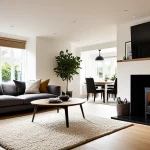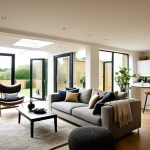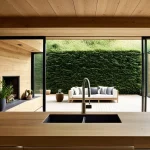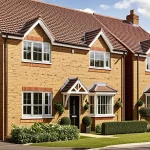Personalising Your Space: Foundational Principles in UK Home Design
Personalising your home starts with understanding your personal style in home design UK and how it translates into your living environment. Recognising what aesthetic resonates with you personally is crucial: is it minimalist, traditional, eclectic, or a fusion? This awareness guides how you approach custom home interiors UK, ensuring that your space truly reflects who you are.
In UK homes, this personal expression must be balanced thoughtfully with practical living needs. Housing layouts and sizes in the UK often require creative solutions to blend personality with functionality, especially in common areas like kitchens and living rooms where flow and utility are key. The UK home design principles emphasise this balance—offering a blueprint for making spaces both appealing and practical.
Also read : How Does Smart Technology Enhance Comfort in UK Homes?
Additionally, the rich architectural history found across the UK heavily informs personalisation choices. Period properties such as Georgian or Victorian homes come with specific features that can dictate design direction. For instance, high ceilings and large windows might encourage airy, open interiors while sash windows and decorative cornices lend themselves to period-appropriate furnishings and accents. Understanding these influences helps homeowners integrate their personal style authentically, respecting the custom home interiors UK context shaped by these historical elements.
By focusing on your unique aesthetic while aligning with the functional demands and architectural character of UK homes, you can create a living space that is both individual and harmonious with established UK home design principles.
Additional reading : How Can Small Space Solutions Transform Your UK Home?
Choosing Colours and Textures that Showcase Personality
Exploring colour schemes UK homes embrace today reveals a dynamic palette blending tradition with modern flair. To reflect your personal style in home design UK, begin by selecting hues that resonate emotionally yet complement typical UK lighting and room sizes. Soft neutrals paired with accent tones—such as muted blues or warm terracottas—allow expression without overwhelming the space. This approach aligns with UK interior design trends, which favour adaptability and longevity over fleeting fads.
Textures play a crucial role in conveying mood and character within custom home interiors UK. Incorporating varied textiles like velvet cushions, woven rugs, or tactile wallpapers introduces depth and invites comfort. For example, layering plush fabrics in a sitting room adds warmth that contrasts gracefully with the often crisp, painted walls typical in British homes. These tactile choices enhance personalisation while supporting the practical and aesthetic demands of UK living spaces.
Balancing vibrant colour and texture with classic British palettes ensures your design avoids clashing with broader UK home design principles focused on harmony and coherence. Bold colours should be used selectively—perhaps through artwork or small furnishings—to maintain visual flow. Embracing this balance encourages a timeless interior that still carries distinct personality, illustrating how colour and texture choices are key tools for personalising UK homes effectively.
Personalising Your Space: Foundational Principles in UK Home Design
Personalising your home begins with a clear grasp of your personal style in home design UK and how it translates into tangible interior choices. This means identifying the aesthetic qualities that resonate with you—whether modern minimalism, rustic charm, or eclectic blends—and thoughtfully applying them within your space. The process is not simply about preference but also about how these stylistic decisions adapt to practical realities within UK homes.
Balancing individual taste with UK home design principles is essential because British living spaces often come with specific constraints, such as smaller room sizes or particular layouts like terraced or semi-detached houses. For example, a bold design element must be moderated to support everyday functionality and comfort without overwhelming limited square footage. Therefore, personalisation in custom home interiors UK involves harmonising flair with livability.
Moreover, the UK’s rich architectural heritage heavily informs personalisation. Historic homes—whether Georgian with their symmetry and proportion, or Victorian with ornate detailing—provide a framework that encourages sensitive custom home interiors UK. Incorporating features that honour period characteristics, like mouldings or sash windows, allows your unique style to complement rather than conflict with established UK home design principles. This approach preserves architectural integrity while fostering an environment that feels distinctly yours, blending personal expression with cultural context.
Personalising Your Space: Foundational Principles in UK Home Design
Understanding your personal style in home design UK requires more than knowing what looks appealing; it involves translating your aesthetic preferences into practical interiors that suit UK living conditions. For instance, bespoke furniture or layout choices should align with the typical spatial constraints of British homes. This ensures your custom interiors remain functional without sacrificing your unique style.
Balancing individual taste with UK home design principles means adapting your vision to fit common features of UK residences, such as compact layouts or multi-use rooms. Practicality often necessitates clever storage solutions or flexible furnishings that support everyday living while showcasing your personality. For example, a statement wallpaper might unify a small room’s design without cluttering the space.
Furthermore, UK architectural history deeply influences personalisation choices. Many homes retain characteristic elements like sash windows or fireplaces, and respecting these features in your custom home interiors UK fosters harmony between new and old. Understanding these historical contexts lets you blend modern personal touches with period features, reinforcing both aesthetic cohesion and cultural identity fundamental to effective UK home design principles.
Personalising Your Space: Foundational Principles in UK Home Design
Understanding your personal style in home design UK is the cornerstone of creating interiors that truly speak to who you are. It goes beyond mere decoration; it involves translating your tastes into practical elements that suit the unique challenges of UK homes. This means considering how your preferences align with typical floor plans, room sizes, and daily living patterns common across the country. For example, while you might favour open-plan spaces, UK residences—especially older or period properties—often feature more compartmentalised layouts, requiring bespoke solutions to merge your stylistic vision with spatial realities.
Balancing individual expression with UK home design principles is essential because function cannot be sacrificed for aesthetic alone. Practicality in UK homes often demands efficient use of space, clever storage, and adaptable furnishings. A personalised interior that respects these necessities will result in a home that feels comfortable and liveable as well as distinctive. By applying these principles, your style becomes integrated rather than imposed, creating harmony between your personality and everyday usability.
Moreover, the influence of UK architectural history deeply informs personalisation strategies. Period homes such as Georgian or Victorian properties come with defining features—like mouldings, sash windows, or fireplaces—that shape design possibilities. Respecting these elements in your custom home interiors UK is vital. It involves a delicate balance of enhancing character without overwhelming heritage details, ensuring your home remains authentic while reflecting your unique style. This sensitive approach embodies core UK home design principles, marrying tradition with modern personalisation for a coherent and meaningful living environment.






